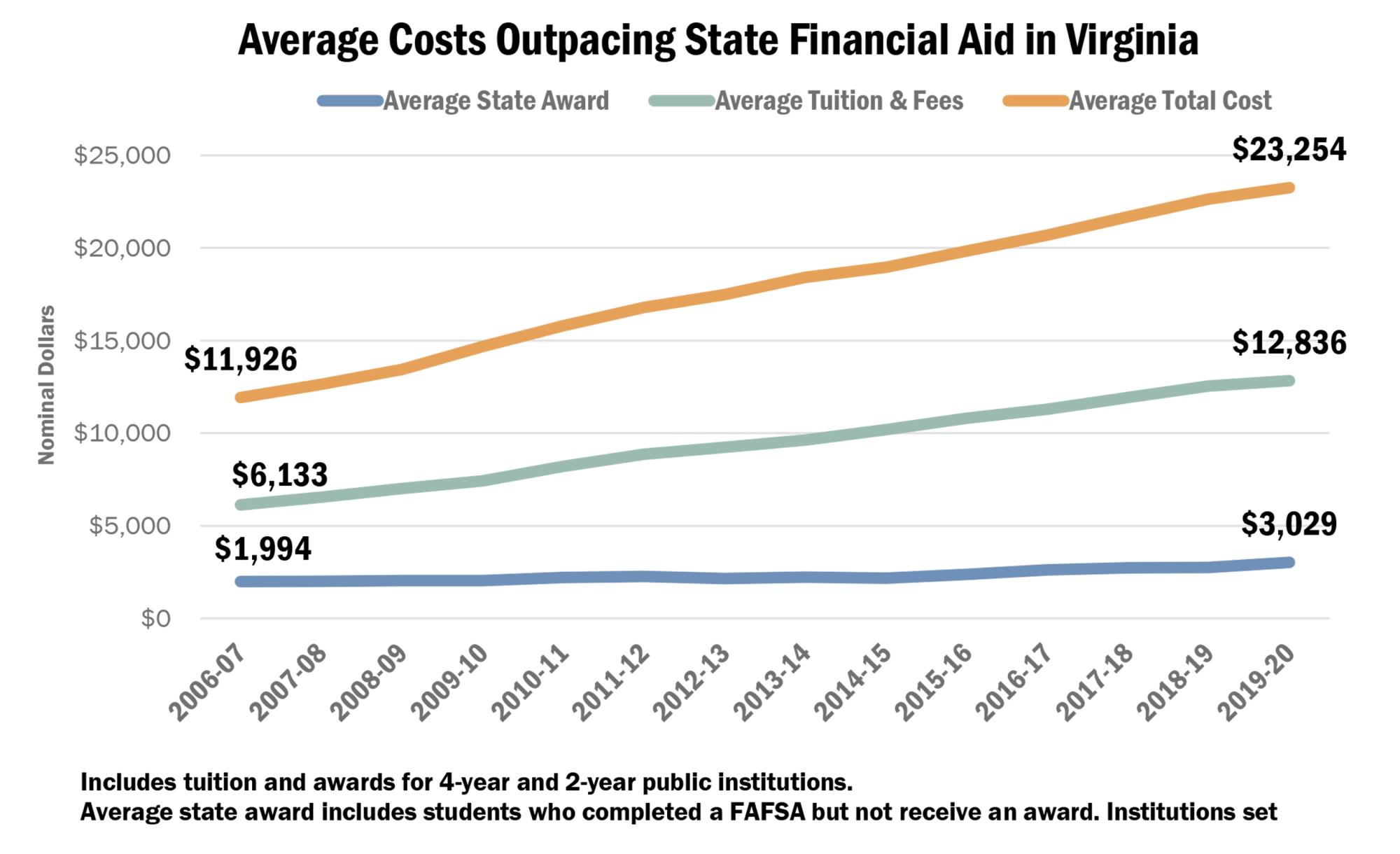In October, SCHEV recommended Virginia increase funding for higher education by $701 million in the 2023-24 biennium. Two categories made up the lion’s share: $224 million for faculty talent and to avoid steep tuition increases and $150 million for need-based undergraduate aid. SCHEV recommends distributing these funds to institutions based on our 2019 Review of Financial Aid Funding, which changed the formula to fund institutions based on an adjusted average unmet need of an institutions’ students. (More on the details of the formula below.)
SCHEV calculates the unmet need of every student in Virginia by: taking the full cost of attendance and subtracting each students’ grant aid and their estimated ability to pay. What’s left is that student’s unmet need. Despite state and federal gift aid, low-income students still have higher unmet need than middle-income and high-income students. And there is wide variation in unmet need between institutions. You can read more about financial aid in Virginia, including federal, state, institutional and private/local sources, and their impact on affordability in our recent report on financial aid at public institutions.

Why fund financial aid based on average unmet need? Financial aid and reduced unmet need increase student graduation rates. Research at the national level, as well as in other states and in Virginia are consistent on this point. So funding financial aid based on unmet need is a strategy to improve student success. SCHEV estimates that our recommended increase would add, on average, more than $950 per student statewide, and between $1,500 and $2,000 per student at the six institutions demonstrating the highest levels of need (George Mason, Radford, Old Dominion, Norfolk State, UVA-Wise and Virginia State).
Why such a significant increase? While state funding for undergraduate need-based aid has increased over the last two decades, those dollars aren’t going as far as they used to. The purchasing power of the average state award, as a percentage of tuition and fees, has declined since 2006-07, when state aid covered 33% of average tuition and fees. In the 2019-20 school year, average state aid covered 24% of average tuition & fees. Looking at the full cost of attendance, including costs like room and board, average state aid only covered 13% in 2019-20, down from to 17% in 2006-07.

Sources for chart above:
https://research.schev.edu//tuitionfees/tfrb_resund_report.asp
https://research.schev.edu//fair/VASFAP_ALL_Report.asp
Tuition is relatively high at Virginia’s public institutions. As part of SCHEV’s annual tuition and fee report, we noted that our doctoral institutions have the 7th highest tuition in the nation and 4th highest for comprehensives. Virginia has a goal of in-state tuition dollars making up 33% of the cost of college, with the state picking up the other 67%. That’s a goal we’ve always fallen short of (the split was 50/50 in 2021-22). If we met that cost split goal, average tuition could be $2,700 lower.
If state aid carried the same purchasing power that it did in 2006-07, tuition would need to be $3,520 lower -- an amount lower than if the cost split goal was achieved. So even if we met the state cost sharing goal, which would cost far more than the $150 million SCHEV proposed for financial aid, state aid would still have a lower purchasing power than it did in 2006-07 (30%). On the other hand, restoring that purchasing power through additional aid would add $1,144 in average aid, and SCHEV’s recommendation tracks very closely to that.
What other changes did our formula make? When making budget recommendations, SCHEV makes a number of important modifications to the calculation of unmet need. The most significant is that we use the state average cost of attendance as each students' starting point in the unmet need calculation. This is important because the cost of attendance varies significantly by institution, ranging from $37,414 at the College of William & Mary to $20,466 at Norfolk State University for 2021-2022. Using average cost of attendance as the starting point of the calculation benefits institutions that keep student charges low, and avoids financial aid from “chasing tuition,” a key priority from the 2019 study. In our budget calculations we also don’t allow a student’s unmet need to exceed tuition and fees. This makes sense because while that need is very real to a student looking at their total bill, state aid cannot exceed tuition and fees. The formula also incentivizes additional enrollment of low-income students by allocating funds based on each students’ Expected Family Contribution (EFC) on a sliding scale. This schedule is similar to how the federal government awards Pell grants.
The Takeaway
Virginia has made progress investing in college affordability, both by moderating tuition through additional operating support and by investing in state financial aid. But at the end of the day, tuition has risen faster than state aid. In 2006-07, the average state award covered 33% of average tuition and fees; that rate has fallen to 24% in the 2019-20 school year. That’s why SCHEV recommended a $150 million increase in undergraduate need-based aid for the next biennium.
Welcome to Insights, SCHEV's platform to interpret and communicate data and policy with the overall goal of informing policy-making, engaging institutions and drawing attention to these resources. Centered around SCHEV's nationally leading data collection, each Insight will visualize complex ideas and help inform funding and policy decisions.
